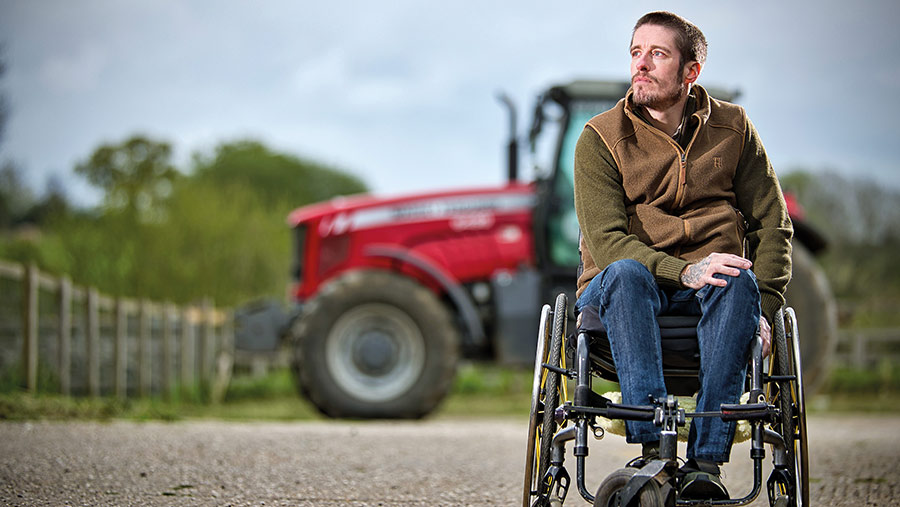Dying to Feed You: Mike Nixon fell 28ft through a shed roof
 Mike Nixon © Richard Stanton
Mike Nixon © Richard Stanton Mike Nixon fell through a shed roof to clean the guttering. He landed on a concrete scrape passage and sustained a serious spinal cord injury.
It began like a normal work morning but ended in disaster. Watch him tell his story in the video and read the rest of the report below.
See also: Find out more about our Dying to Feed you campaign
It was a regular morning. We met in the yard as usual – about 7.30am. We were having the usual conversation about what we were doing that day.
It was raining and the gutter was blocked with trash, so the water was overflowing into the shed.
I had the idea of going up there and sorting it out. I am that sort of person – I see a job in front of me that needs doing, and I just get on with it.
So I didn’t use any harnesses or crawling boards or anything like that.
I got my mate to put me up in the loader bucket. Once I was up there, I walked along the beam either side of the gutter between the two sheds.
The roof on one side was corrugated tin and on the other side was asbestos.
My granddad was a farmer and my stepbrother, Chris, also farmed. I’ve always loved livestock, and the plan was for me to work on a livestock farm, but to have a mixed arable farm too.
I’d started out at the age of 16 at Moulton College. I’d joined Young Farmers and ended up doing the AGMs in Blackpool and stuff like that.
It was a great friendship group – but the farm safety side of things didn’t feature so much.
When I started out with my employers, safety was a big thing. But on a farm, you don’t always see the danger until it’s too late.
Obviously there was a danger there. It’s one of those things that you think: “It won’t happen to me.” But it did.
The sheds themselves were probably 60-70 years old. But the beam was solid metal, so I decided to straddle it, thinking I would be safe.
There was a shrub growing in the gutter. I pulled it and a piece snapped off, which threw me backwards.
They told me I wouldn’t walk again
I lost my footing and my left foot went though the asbestos.
I fell 28ft and landed on the concrete scrape passage where the calves were. If I had landed about two or three feet to one side, I would have landed on fresh bedding and it would have been a completely different situation. But I didn’t.
I knew straight away I had lost my legs. I couldn’t feel them at all. My work mate with me told me to keep calm and just stay still. Then he rang for the ambulance.
He was so calm and chilled, it really helped.
I remember getting to the hospital. The consultant told me I had a pretty bad spinal cord injury. I had broken my sternum and seven ribs.
They told me I wouldn’t walk again and I spent the next three months lying flat on my back.
I cried at first. But once I got over the initial shock, I knew I had to get on with it.
I go to the gym, and maybe one day I will recover. But I don’t do the gym stuff just on the off-chance that a miracle will happen and I might walk again.
For me, the gym is my way of going somewhere and being able to forget about everything.
On that day, I didn’t see the danger. And looking back at some of the other stuff I used to do on the farm, I was lucky to get away with it.
Unfortunately, that one time I didn’t get away with it. I’m lucky to still be here.
My message is that you can say no.
If there is something your farm manager or your boss asks you to do and you don’t feel happy doing it – maybe because you don’t have the right qualifications or training – then just say no and stay safe.
How to reduce risk when doing roof work
- Falls from roofs, and through fragile roofs and roof lights are one of the most common causes of workplace death and serious injury
- You should consider whether the work needs to be done – or could it be done in some other way, such as from below or from an integrated work platform
The Health and Safety Executive says you should:
- Plan the work
- Set aside enough time to do it
- Take account of weather conditions
- Make sure everyone knows the precautions to be followed
- Fix a prominent warning notice at the approach to any fragile roof
- Never walk on fragile materials such as asbestos or other fibre cement sheet, roof lights or glass roof lights – and remember some glass may have been painted over
- Never “walk the purlins” or “walk the line of the bolts”
- Roof ladders or crawling boards must span at least three purlins. They should be at least 600mm wide – more if required
- Don’t use a pair of boards to “leapfrog” across a fragile roof, but provide enough boards
- Take precautions to prevent a person falling from the ladder or board
- Use edge protection or safety harnesses, or safety netting where this is not feasible. Take specialised advice
- Roof ladders must be securely placed, with the anchorage bearing on the opposite side of the roof. Never use gutters to support any ladder.
Dying to Feed You
 About the campaign
About the campaign
Farming has the highest number of workplace fatalities of all occupations. Farmers Weekly is pledging to use its voice, influence and reach to reduce the accident rate in agriculture.
Find out how you can be a part of helping us change agriculture’s safety record at fwi.co.uk/dying-to-feed-you
Partner message

The team at Safety Revolution are delighted to be working with Farmers Weekly to reduce deaths in agriculture and to show how we can work together to create safer farms.
Building strong and positive safety cultures delivers happy and safe teams, fewer incidents and improved productivity. We look forward to exploring individual case studies and shining a light
